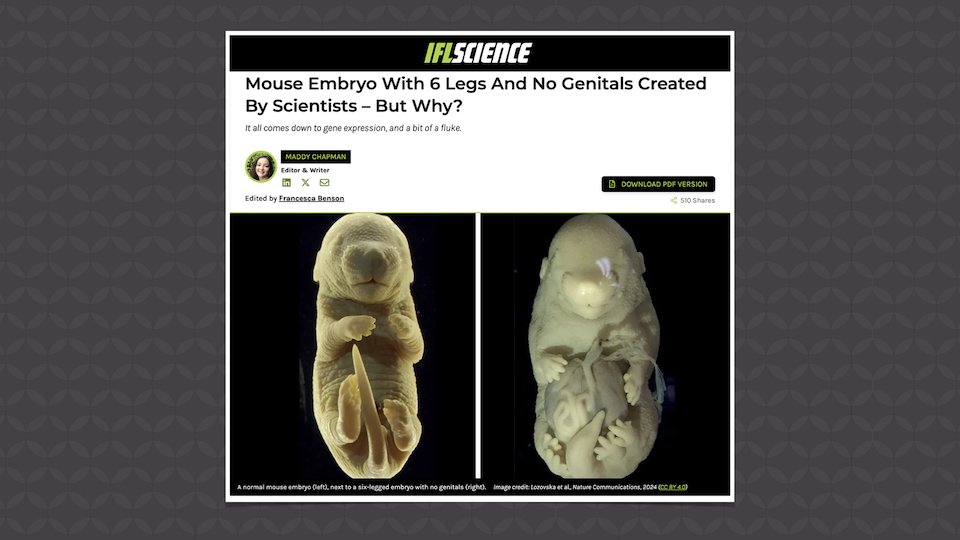
Why Did Scientists Create Severely Deformed Mouse Embryo with Six Legs?
A recent news article detailed an experiment by developmental biologist Moisés Mallo and his colleagues who were studying a receptor protein important in embryonic development—Tgfbr1. The article states,
The team inactivated the gene responsible for producing the protein in mouse embryos that were around the halfway point of development, intending to investigate how this change affected the developing spinal cord.
Instead, they found something unexpected: one of the bioengineered embryos had two extra legs where its genitals should be.
Tgfbr1 (transforming growth factor-beta receptor type 1) plays a key role in controlling the formation of the external genitalia and hind limbs. According to the article,
[The researchers] discovered that Tgfbr1 helps dictate whether these structures become either genitals or limbs. It does this, they realized, by altering the way that DNA folds in the structure’s cells. As a result, deactivation of the protein changes the expression of other genes – in this strange case, at least, that meant additional limbs and no genitalia.
The associated journal article goes on to state that the extra pair of legs are “malformed” and that “the gut failed to generate normal rectal-anal structures.” Instead, the posterior end of the intestinal tube merged with a small bladder connected to a urethra. In other words, playing with the embryos gave us a six-legged (albeit two of them malformed), mouse with no genitals, a malformed bladder, and an incomplete urinary tract. Not exactly an “onward and upward” mutation. Furthermore, the researchers admit that the whole process of embryo development is quite complex (which creationists, of course, know is the case as God designed life).
The identification of chromatin elements uniquely associated with hindlimb and GT [genital] fates might guide the search for the molecular signature that specifies hindlimb or GT development. The large number of elements in each group suggest that these signatures might be quite complex, likely involving the combined activity of several factors. Identification of those factors will be challenging, considering that in mammals enhancers are typically located far from the genes they regulate, which are often not even the closest transcription unit.
It should be no surprise that the created genetics (and associated regulatory processes) of animal and human embryos are complex and if tinkered with will create disabling, harmful, or fatal consequences. God created each creature to be able to reproduce according to its kind, which necessitates that their embryos develop normally. Yes, because we live in a fallen world, there are harmful mutations which sometimes creep in, but these are very small percentages. When was the last time you saw a six-legged mouse (or squirrel or deer) in the wild?
But the unanswered question in the news article’s title, as to why the researchers even performed this experiment in the first place, is answered at the end:
Our work uncovers a remarkable tissue plasticity with potential implications in the evolution of the hindlimb/genital area of tetrapods [four-limbed vertebrates], and identifies an additional mechanism for Tgfbr1 activity that might also contribute to the control of other physiological or pathological processes.
God has woven “remarkable tissue plasticity” into embryonic development. But this has nothing to do with evolution.
Yes, God has woven “remarkable tissue plasticity” into embryonic development. But this has nothing to do with evolution, which was what the researchers were attempting to prove. It does however have everything to do with God, the common Designer of all animal and human life.
O Lord, how manifold are your works! In wisdom have you made them all; the earth is full of your creatures. (Psalm 104:24)
Get More Answers on Answers News
This item was discussed yesterday on Answers News with cohosts Dr. Tim Chaffey, Bryan Osborne, and Patricia Engler. Answers News is our weekly news program filmed live before a studio audience here at the Creation Museum, broadcast on our Answers in Genesis YouTube channel, and posted to Answers TV. We also covered the following topics:
- Man arrested for child pornography before he could abuse surrogate baby
- Is the earth spinning faster than it used to?
- Did Biden proclaim Transgender Day of Visibility on Easter Sunday?
- And more!
Be sure to join us each Monday at 2 p.m. (ET) on YouTube or later that day on Answers TV for Answers News. You won’t want to miss this unique news program that gives science and culture news from a distinctly biblical and Christian perspective.
Thanks for stopping by and thanks for praying,
Ken
This item was written with the assistance of AiG’s research team.
Most Recent News
-
Oct. 31, 2024 from Ken Ham Blog
A new study from Barna found a shocking 54% of “practicing Christians” admit to viewing pornography—that’s a mere 14% difference from non-Christians (68%).
-
Oct. 28, 2024 from Ken Ham Blog
Andy Stanley began a new series with the question, “Do you have to believe in miracles to be a Christian?” His answer? Yes, but only two foundational miracles.

Answers in Genesis is an apologetics ministry, dedicated to helping Christians defend their faith and proclaim the good news of Jesus Christ.
- Customer Service 800.778.3390
- © 2024 Answers in Genesis



